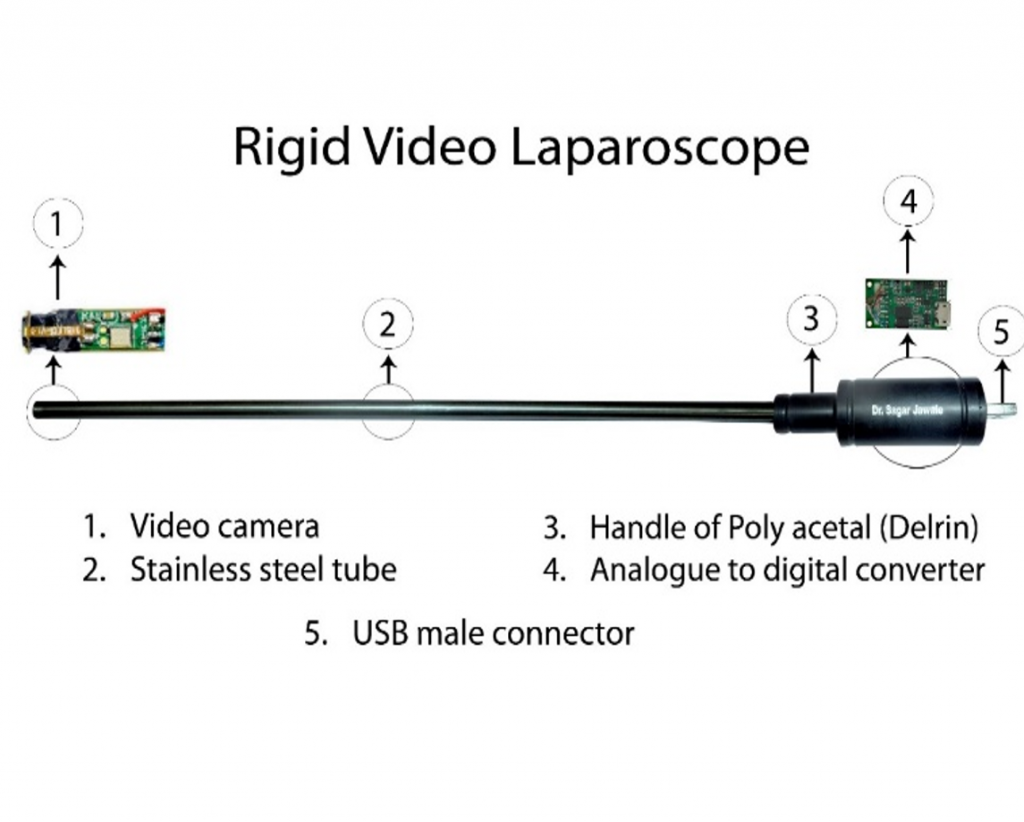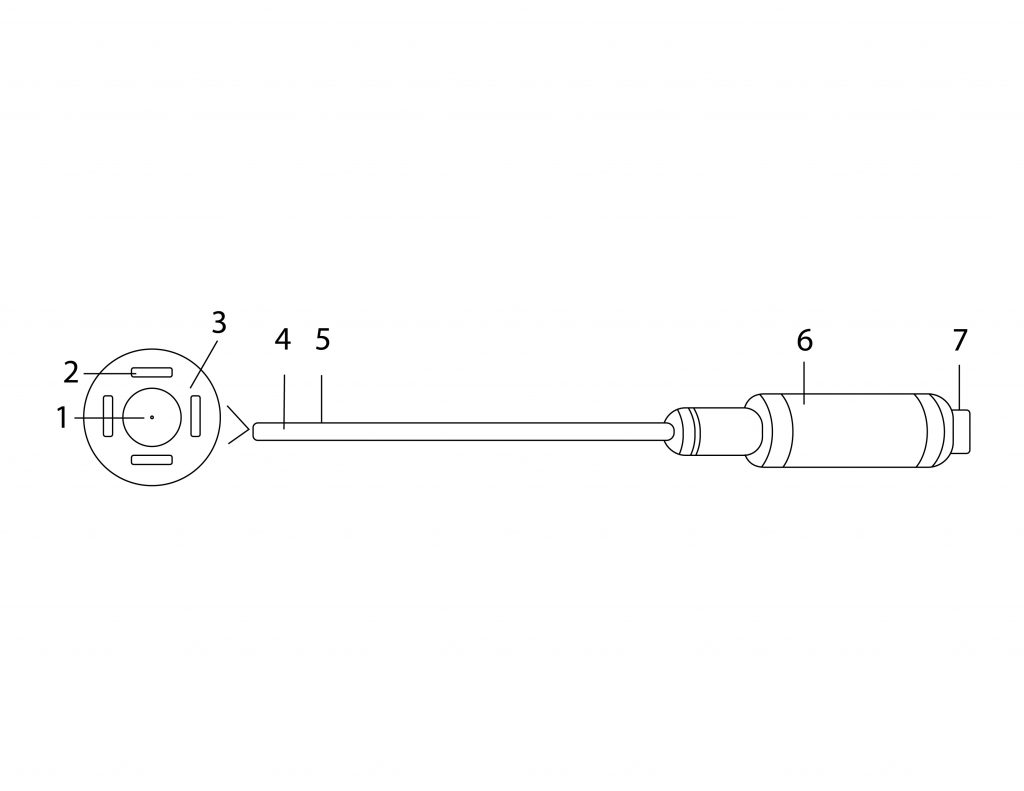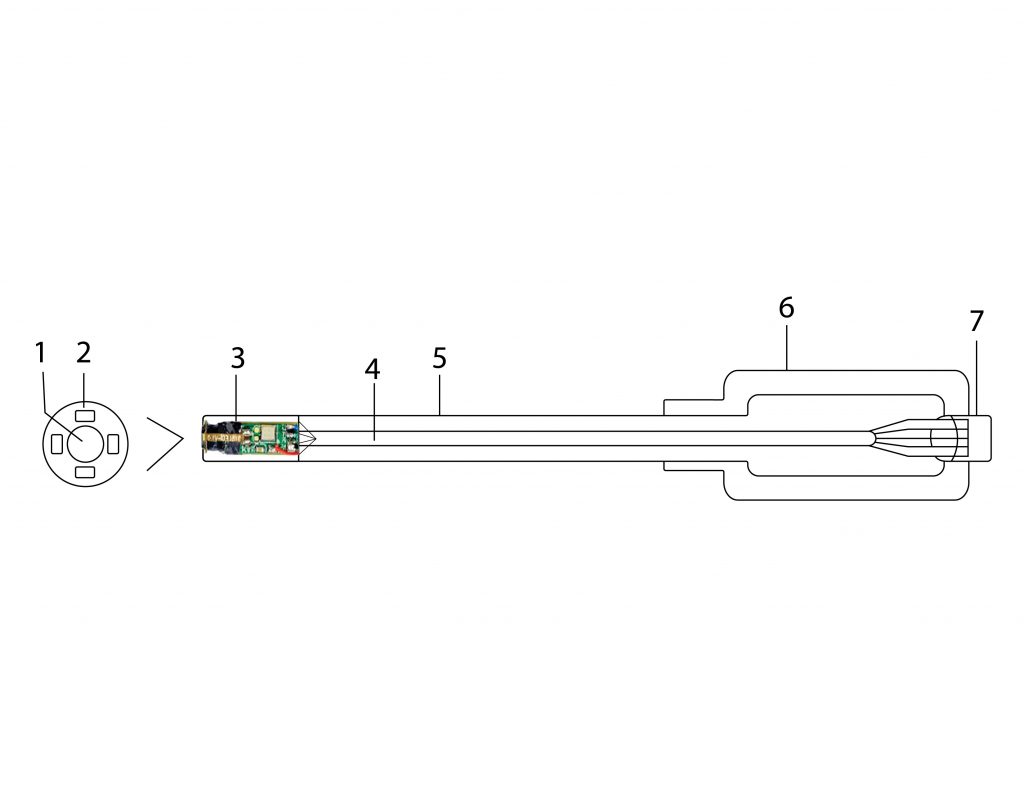Product name: Rigid Video Laparoscope- 5, 10mm
Trade name: USB Lapcam R 5, USB Lapcam R 10
Product Specifications: The rigid video laparoscope is a cheap, light weight and compact medical device, 3 in 1 in the nature, a unique merger of a Telescope, light source, and endo-camera with a tubular video camera with LEDs (Light emitting diodes) in front with a USB output at the back end. It comes in 5- and 10-mm diameter sizes. It has 30 cm working length and 8 LEDs at the tip for illumination with zero-degree vision.
Complete Specifications: The detailed description of the invention is as follows: I describe a rigid video laparoscope with a tubular video camera with LEDs (Light emitting diodes) for illumination fixed at the tip of a tube with a holder at the back end and a USB pin as output used for a medical procedure called laparoscopy.

Rigid Video Laparoscope: 3 in 1
A Rigid Video Laparoscope is a short, tube-like medical instrument that is approximately 30 centimeters in length. It has eight powerful LED lights at the end, with a mounted digital video camera. This set-up ensures proper video imaging in the human body, preferably the abdominal cavity, to render laparoscopy safer and more effective.
What makes this instrument so revolutionary is its 3-in-1 functionality. It is used as:
- A visual examination telescope,
- An endo-camera for high-resolution photography and videography, and
- A source of light, powered by LED technology to provide a beam of maximum light.
- A USB port on the rear of the scope allows for direct attachment to external devices like monitors, laptops, tablets, or cell phones. This allows for real-time monitoring of the surgical area and documentation of procedures without the use of cumbersome, expensive equipment.
The device is made up of a hollow tube. (Figure 1-2, Figure 2-5) A tubular video camera (Figure 1-4, Figure 2-3) is fixed at the tip of this tube. The camera fixed at the tip of the device has many LEDs (Figure 1-2, Figure 2-2) emitting white light which illuminate the operating field during the procedure of laparoscopy. The video camera and LEDs are covered with a water-proof glass (Figure 1-3) over them. The video camera has lenses which concentrate light on the sensor which converts it into an analogue electrical signal which is converted by an analogue to digital converter into a digital signal. The whole circuit board of the camera is in the tubular head itself. This signal is sent by electrical wires (Figure 1-4) to a USB (Figure 1-7, Figure 2-7) pin fixed at the back end of the device as a USB output. The device has a holder (Figure 1-6, Figure 2-6) at the back end used for holding the device. It accommodates the metal tube in front and has a USB pin at the back end. A USB wire connects the device to variety of devices such as desktop, laptop, android mobile phones and android-based tabs. The device comes with software which needs to be installed on the device to see and records the images and the video.
The device is reusable and can be sterilized by putting in Formalin chamber for 30 minutes or by Ethylene Oxide gas.
The advantages of the device over the conventional are as follows: It is a compact and lightweight device which weighs only 75 gm. The conventional laparoscopy system weights at least 500 Gm along with an endo-camera. It is 3 in 1 in the nature and is a unique merger of a Telescope, light source, and endo-camera. It is commercialized at a reasonable cost of Rs.30,000 compared to Rs. 6 Lakhs of the conventional equipment. The picture quality is excellent due to the “Chip on Tip” technology and there is no image loss as in conventional instrument.

Major Features of the Rigid Video Laparoscope
Integrated Design: The integrated design makes the device highly user-friendly. Instead of having separate instruments for visualization, imaging, and lighting, the video laparoscope has all three in one single unit, which is easier to use during the surgical process. This eliminates the time required for set-up and enhances ease of use, very convenient for emergency or rural settings.
Digital Imaging and Waterproof Camera: The most sought-after feature is probably the waterproof endo-camera. High-quality digital images and video are produced, even within fluid-filled body environments. Chip-on-tip technology offers minimal distortion and optimal image clarity, enabling precise diagnosis and treatment.
Portability and Cost-Effectiveness: Rigid Video Laparoscope is only 75 grams heavy, far lighter than older laparoscopic instruments. The heavier systems of approximately 500 grams previously required additional stabilization and support.
Price is another key aspect that sets apart the rigid video laparoscope. While machines for conventional laparoscopy may cost up to ₹6 lakh (about $7,000 USD), one may acquire a rigid video laparoscope for as little as ₹30,000 (about $350USD). This huge difference in price makes it ideal for low-income or rural healthcare institutions.
Medical Applications of the Rigid Video Laparoscope
The video laparoscope has numerous medical uses, particularly in abdominal exploration operations. Some of its principal uses are:
- Abdominal Laparoscopy: For diagnosing unexplained abdominal pain, abdominal tuberculosis, or endometriosis.
- Cholecystectomy: Removal of the gallbladder.
- Herniotomy: Hernia repair operation.
- Orchiopexy (Orchidopexy): Repairing undescended testes.
- Gynecologic Procedures: Such as ovarian cyst removal and uterine examination.
Its versatility and ease of use make it a value added to specialist and general surgeons alike.
How to Use a Rigid Video Laparoscope
It is simple to use but requires meticulous preparation. Here is the general procedure:
Pre-Surgical Preparation: The patient must fast for 6 hours prior to surgery for an empty stomach.
The equipment must be inspected by the surgeon for cracks or damage, LED lighting checked, and the camera properly focused.
Device Connection: USB output is connected to an appropriate device such as a display monitor or Android phone.
Special software needs to be installed in order to see images and videos acquired from the laparoscope.
Procedure
A tiny incision (typically less than half an inch) is created in the abdominal wall. The rigid video laparoscope is inserted through the incision. Carbon dioxide gas is the most frequently used gas to inflate the abdomen and provide an improved image. The surgeon performs whatever surgical maneuvers are needed using real-time images on the connected device.
Why to buy it
The Rigid Video Laparoscope is a new device that is easier to obtain for laparoscopic surgery, especially in developing nations. Portability, internal capabilities, and affordability make it a superior device compared to traditional tools. From minor diagnostic tests to complex surgeries, the video laparoscope is a fundamental invention that contributes towards accuracy in surgeries at lower healthcare expenses.
As technology advances, tools such as the rigid video laparoscope will be key to delivering quality surgical care to underserved patient populations across the globe.
Figure 1 showing the outer view of the rigid video laparoscope with a magnified front as a side view
1.Video camera 2. Light emitting diodes (LEDs) 3. Front water-proof glass over the camera and LEDs 4. Video camera with LEDs 5. Metal tube 6. Handle 7. USB pin

Figure 2 showing the outer view of the rigid video laparoscope with a magnified front as a side view
1.Video camera 2. Light emitting diodes (LEDs) 3. Video camera with LEDs 4. Electrical wires from front camera to USB pin 5. Metal tube 6. Handle 7. USB pin
Intended application: The instrument can perform a variety of diagnostic procedures such as diagnostic laparoscopy for abdominal pain, abdominal tuberculosis, endometriosis etc. It can perform a lot of therapeutical procedures such as laparoscopic appendicectomy, herniotomy, orchidopexy, cholecystectomy etc.
Method of using device: The device is sterilized by Ethylene Oxide gas. It is connected by a sterilized USB cable to the display devises. The USB pin powers the camera and LEDs, and image is displayed on display devises. A software installed on the display devises can record still images and video on the hard drive.
Class B
Material: 316 grade stainless steel
Patent No: 201621037859
Packing & storage Condition: The product is stored in a dust free cabinet at 25-40 % centigrade temperature. It is packed with multiple layers of bubble wraps and placed in a metal container of appropriate size and sent by courier
Publication: https://misjournal.net/article/view/3123
Video quality: https://www.youtube.com/watch?v=22gzPw12j-8
Cost: Rs.30,000


